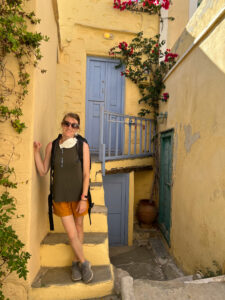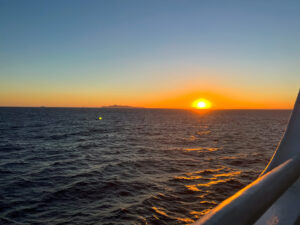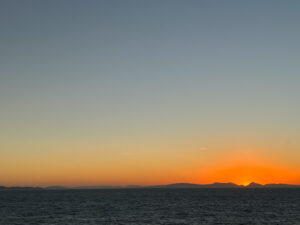
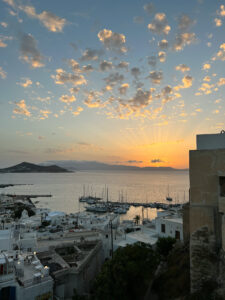
If you’re planning a trip to Greece, the internet will provide you with approximately 4 billion articles on the “top Greek islands to visit.” All 4 billion of those articles will feature different islands, vehemently insist that their islands are the correct choices, and assure you that if you make the “wrong” choice, your vacation will be ruined. I read more of those articles than I can estimate, nearly made a PowerPoint to show Michael so he would help me pick, triple booked rooms while I thought about it, and ultimately let ferry routes and accommodations help me decide. After about the 4th article, peoples’ opinions stop being helpful (though the photos are still pretty to look at), and you probably can’t go wrong with most any Greek island. But I am particularly delighted by the islands I settled on.
There are over 200 inhabited Greek islands, and they are categorized in different groups. Each island has its own character, but the islands within each group typically share influences and architectural style and history. Probably the most famous island group in Greece is the Cyclades. These are the islands you’ve seen countless photos of—the white stone houses with the blue domes. When picking the islands I wanted to visit, I knew I wanted to see the most famous Cycladic island, Santorini, and it made the most sense to stick with other Cycladic islands since the ferry routes between several of them are quick and direct. And after much deliberation, I settled on Santorini, Naxos, and Syros.
Naxos is the largest island in the Cyclades, and though it has the same iconic architecture as Santorini, it’s not nearly as crowded. Though it’s one of the more popular Greek islands, it felt practically empty at the end of September. Our Airbnb host, Maria, picked us up from the port, drove us to our apartment, and spent 10 minutes huddled over a map with us pointing out all her favorite restaurants and recommendations. The Airbnb was simple, but the hospitality was exceptional. Though Naxos Town (the largest town on the island) is relatively small, it felt like a winding maze. We were a short walk from the center of town, but after 3 nights in Santorini, Naxos felt calm, quiet, and affordable.
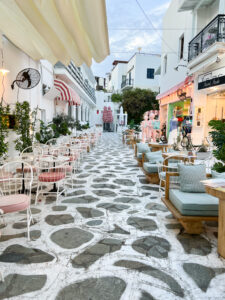

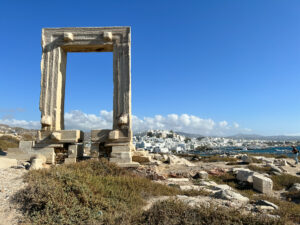
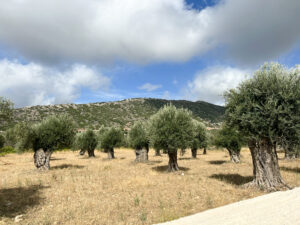
The first morning, we took a bus to the center of the island to see some of the smaller villages. I hadn’t known to expect such mountains. We spent a few hours wandering around Halkali and Filoti. When I imagined Greek islands, I didn’t know to imagine small inland towns like these full of locals and elementary schools. We asked one of our waiters in Filoti how often he goes to Naxos Town or even to the mainland, and he shook his head. Not often. Everything he needs is there in his little village. For a glimpse of how locals truly live on the islands, visit the villages of Naxos in the off-season.
The equally famous island, Paros, is right next to Naxos, so we took a day trip there as well to explore Parikia and Naoussa and eat dinner on a docked boat. It was easy to tell the tourist season was nearly over. Even the most crowded restaurants still had plenty of tables available during sunset.
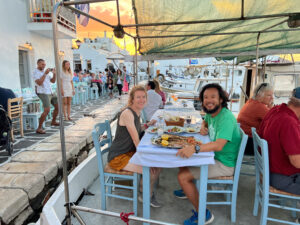

The next day we planned to rent a scooter, but we needed a motorcycle license to do it. Michael has a motorcycle license, but I don’t, so we decided to go with an ATV instead so that we could both drive. The shop owner handed us the keys, gave us 20 seconds of instruction, and wished us a good day. I was shocked at how easy the whole process was, and there we went, driving on main roads in regular traffic will our ill-fitting helmets. I had Michael drive us out of town, and then I drove us the rest of the way to the beach. The water was a little cold for swimming, but other than a few naked neighbors, we had the whole beach and our choice of beach umbrellas to ourselves. We explored the beaches, watched the sunset from a rooftop bar, and ate one of the most delicious meals I had in Greece next to our apartment. Naxos isn’t as glamorous as Santorini, nor does it have views as stunning, but in many ways, it felt more authentic.
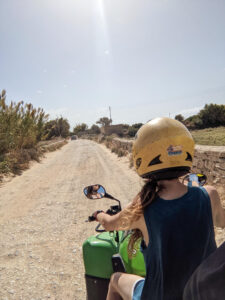

Maria picked us up and drove us back to the ferry for our ride to Syros. Syros was a less conventional choice of island to visit, but in some ways, it was my favorite of the four. Unlike the rest of the Cylades, it doesn’t feature the classic white and blue architecture or famous beaches. Instead, the port town Ermoupoli, the capital of the Cyclades, is a rainbow of multi-colored buildings—a result of its Venetian influence. Syros is a commercial, political, and artistic center where people live year-round, and it’s practically ignored by mass tourism. They don’t need tourists to fuel their economy, so prices are lower.
From the port, we took a taxi up to Ano Syros to the Airbnb I was somehow lucky enough to book months and months in advance. Anos Syros is a small Cycladic village that sits high atop the hill overlooking Ermoupolis. The taxi can only take you so far up the winding hill, and once you enter the village walls, the only transportation are your own feet and an occasional mule. I booked our Airbnb the second I found it—before I even knew that Michael would join me in Greece and before I knew for sure I would even go to Syros. It’s a traditional Medieval Cycladic home made entirely of stone and dating back to at least 1570. It’s one of best-preserved original homes on the island, so it’s relatively famous and featured in many architecture and travel magazines. And somehow, it only cost around $90 per night.
Our directions to the house consisted of instructions like “7 steps down the stairs on the left and then turn and take 16 steps up on the right and then across the tiny piazza with the single tree and then up another 17 steps.” We finally found the place, and it looked like something from a historic film. The kitchen was in an attached-but-separate building because of the fire hazard that kitchens caused centuries ago, and the air conditioner and indoor bathroom on the bottom floor were newer additions. There was exposed rock on the bottom floor, still present from over 500 years ago when the home was being built and tools couldn’t break up the largest stones. It was like staying in a cozy cave. The owner, Yannis, had kept as much original décor as he could in the house, and he sent us pages and pages of information about the history of the home and neighborhood. When I told him I was fascinated and would love to learn more, he was elated and sent me an additional novel’s worth. We didn’t get to meet him in person, but he was the kindest soul.
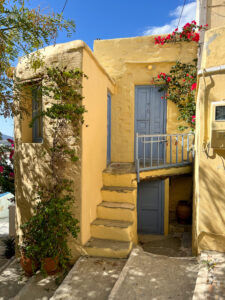
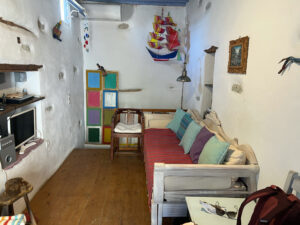
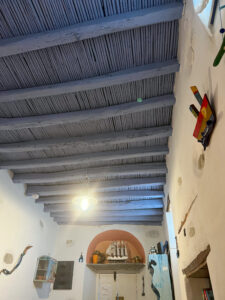

It was the beginning of October, and it felt like we had the entire village to ourselves. It was so quiet in Ano Syros that you could hear the footsteps of each person who walked by outside. A few times I heard people outside the front door taking photos of the house without knowing we could hear them. Once I was teaching Michael how to do the Macarena (which he’d somehow revealed to me a few days before that he’d never learned to do), and a small tour group almost walked by at the right time to witness it through the front door’s open window.
Near 5am the first morning, Michael woke me up and asked if I’d heard that noise. I hadn’t. He whispered, “I think there’s someone in the house. There were footsteps upstairs.” Had I been alone, I’d have cowered under the covers hiding in terror and not emerged until noon, but Michael tiptoed straight up the stairs to confront the intruder. Of course, there was no one. He came downstairs with a shrug and went promptly back to sleep, and I stayed awake contemplating whether the house echoed the footsteps of an early-morning walker outside or whether we had a 500 year-old ghost.
Walking downhill through Ano Syros to reach Ermopoulis is like walking through an ancient maze. Cats watch you, still as statues, and I wondered if they were as ancient as the houses they were guarding. Flowers littered the stones with petals that seemed too bright for October. The island may have been ready to hibernate for the winter, but the flowers weren’t tired yet. They were deep reds and vibrant pinks, showing off. Seeing another person felt shocking, like we were intruders in a dream.
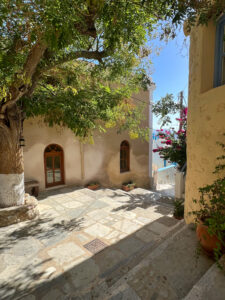
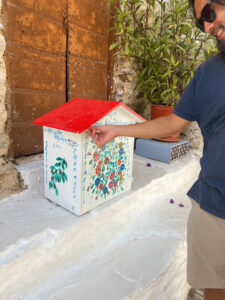


It was a 30-minute walk straight downhill to reach downtown. Near the Miaouli Square a few blocks from the water, clusters of restaurants lined their outdoor tables alongside each other, squeezed into narrow alleys. More than one restaurant we dined in during our stay told us that we were lucky—we’d caught them on their last day open for the season. We have no concept of such “seasons” in the United States, but it’s common here—you open your restaurant when it gets warm in the spring, and then you take a 3 or 4-month vacation when winter’s near. We caught Django Gelato on their last open day of the year. Here, the ice cream is made fresh, and the popular flavors sell out daily. The manager told us how he was leaving for the mainland that week where he’d work in one of their mainland locations for the next few months and continue developing new flavors. He gave us the flavors we ordered but added a spoonful of the flavors he thought we should try and then undercharged us on purpose. On the edge of downtown, locals swim among the rocks in impossibly blue water. There’s no beach here—you simply hop off the sidewalk for a dip before walking the 900 steps up uneven stairways back to Ano Syros.
In October, the ferries only stop in Syros a few days a week, so it felt like the whole island left with us. The gelato shop manager and the owner of Seminario where we ate a delicious first dinner were likely on our ferry, along with the elderly dog wearing a diaper who sat next to us on the outer deck because there were no more seats indoors. It was a beautiful day, but a windy one, and we bounced and rocked for the entire 4 hours as we rode alongside the sunset to the mainland. We spent just over a week in the islands, and it was easy to understand why people keep coming back again and again.

